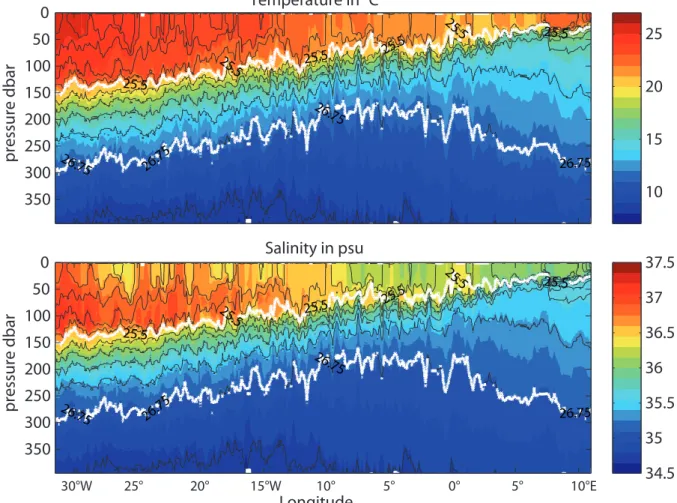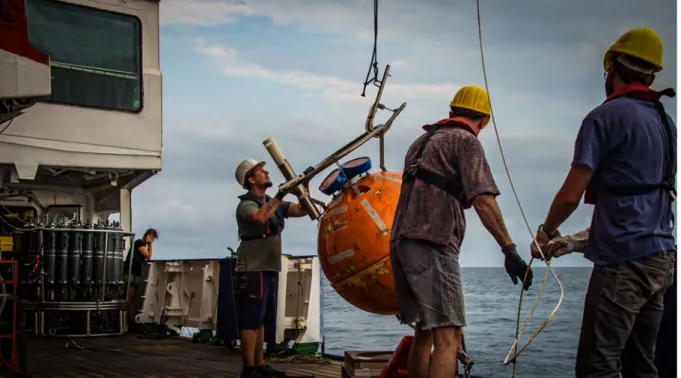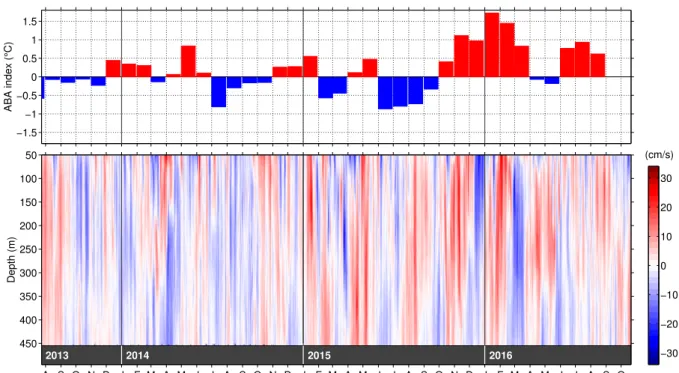Prof. Dr. Peter Brandt Meteor cruise 131
3
rdWeekly Report M131, Recife-Walvis Bay
07.10.-12.11.2016
After nearly two weeks of crossing the Atlantic with continuous underway measurements (Fig. 1), we arrived at our research area off Angola. In 2013, GEOMAR established together with INIP (Instituto Nacional de Investigação Pesqueira Republica de Angola) an observational program consisting of a current meter mooring array as well as regular shipboard and glider measurements at 11°S.
The measurements are aimed to identify the strength of the Angola current as well as the processes relevant for the functioning of tropical upwelling systems characterized by weak wind forcing, but nevertheless high biological productivity and fish.
Fig. 1: Temperature and salinity along ~11°S from Brazil to Angola as measured with the Underway CTD. White and black lines mark contours of potential density (figure by Sören Thomsen).
In comparison to other socio-economic relevant regions of the World Ocean, the observing system off Angola is only weakly developed. However, ocean observations are often the first step toward a better understanding of the system. They can be used to improve our capabilities to simulate and predict atmosphere and ocean
pressure dbar
Temperature in °C
25.5
25.5 25.5 25.5
25.5 25.5
26.75
26.75
26.75
26.75
0 50 100 150 200 250 300
350 10
15 20 25
Longitude
pressure dbar
Salinity in psu
25.5
25.5 25.5 25.5
25.5 25.5
26.75
26.75
26.75
26.75
30°W 25° 20° 15°W 10° 5° 0° 5° 10°E
0 50 100 150 200 250 300 350
34.5 35 35.5 36 36.5 37 37.5
Prof. Dr. Peter Brandt Meteor cruise 131
parameters, for example rainfall, biological productivity or fish stocks that are particularly relevant for Angola. These predictions strongly depend on our knowledge of the evolution of the sea surface temperature off Angola. The sea surface temperature here is forced locally by heat fluxes and wind, but also remotely by the propagation of warm water anomalies along the equator and further southward along the coast off Southwest Africa. The latter events are often called Benguela Niños in case of warm events and Benguela Niñas in case of cold events.
Because of the slower than normal cruise from Brazil to Angola and the date of the reception in Luanda that we had to fix quite early, there was only one day available for our dense observational program at 11°S. During that day, unfortunately we were able to recover only one mooring out of three (Fig. 2, 3). The three autonomous gliders, we had on board, were successfully deployed and sent on mission to measure standard parameters like temperature, salinity, oxygen and chlorophyll together with special microstructure sensors attached to two of the gliders for the measurement of vertical mixing and a nutrient sensor attached to the third glider (see http://gliderweb.geomar.de/html/swarm08.html). During the night the work was continued with the first operation of the ScanFish. This system is used by the working group of IOW. By alternating up- and downward movements it is able to continuously observe the upper ocean while being towed behind the ship at a speed of 6 kn. These observations ended our working program at 11°S and METEOR sailed to our northern most working area that is located close to the Congo river outflow at 6°S.
Fig. 2: Recovery of the top element including the acoustic Doppler current profiler of the mooring within the Angola Current at 11°S (photo: SvN).
Prof. Dr. Peter Brandt Meteor cruise 131
Fig. 3: Sea surface temperature anomaly in the Angola-Benguela area (between 10°S and 20°S, and east of 8°E (a) and anomalies of along-shore flow from the first and second mooring period (b).
Strongest southward flow was observed in December 2015, slightly leading warmest temperatures further to the south (figure by Robert Kopte).
Three colleagues from our partner in Angola, the Fisheries Institute, with whom we have been collaborating with since 2013 are on board METEOR during this cruise.
Here we want to report about their motivation for marine sciences as well as about their experience on board METEOR.
For Enoque Vasco, 50 years old, it is already the second cruise with METEOR: „In 2013 I was aboard METEOR the first time and the work and exchange with our German colleagues was so impressive that I decided to continue my work and write my PhD thesis. Therefore I am really grateful that I have the opportunity to join a METEOR cruise again and have the chance to learn more about the work with all the scientific instruments, which we don’t have in Angola. I studied marine biology and worked some years for INIP in Lobito, where we have a monitoring station, which measures temperature, salinity, oxygen and nutrients of the seawater. A data time series from this station (1968 to 2007) I used for my master thesis. Since 2014 I study oceanography in Portugal at the University of Aveiro and at the moment I am writing my PhD thesis with a focus on hydrography and ocean dynamics in the Economic Exclusive Zone of Angola. My family is based in Lobito and of course I would like to work as an oceanographer in my home country.“
Eridson Saquenha, 32 years old, works for CIP-Namibe, INIP in South Angola and this is his first time aboard METEOR:
2013 2014 2015 2016
Depth (m)
A S O N D J F M A M J J A S O N D J F M A M J J A S O N D J F M A M J J A S O 50
100 150 200 250 300 350 400 450
(cm/s)
−30
−20
−10 0 10 20 30
−1.5
−1
−0.5 0 0.5 1 1.5
ABA index (°C)
Prof. Dr. Peter Brandt Meteor cruise 131
„The teamwork is really great and the dialogue with the people on board is more than immense. Our German colleagues have an extremely wider comprehension of the ocean than we have in Angola. Some of the instruments like e.g. the gliders are absolutely new for me and it is very interesting to work with them and to see how to process the data. I study environmental engineering and my main research is focused on the question why our fish stocks are declining since the year 2010.
During this cruise I learn more about the physical processes in the ocean, which might be responsible for this situation. Furthermore it is wonderful to make new friends aboard METEOR and to learn more about the work of the oceanographers in Germany.“
Paulo Coelho, 43 years old, work for INIP in Luanda and visited the GEOMAR also:
„The international cooperation within the EU-project PREFACE is very important and this cruise fills it with life. In Luanda we don’t have the same equipment as our German colleagues, but I hope instantly that people in Angola will better understand, that we have to develop a better understanding of the physical processes in the ocean.“
At this point, we would like to thank the crew for the great effort round the clock, which is crucial for the success for our measurement program.
Greetings from the tropics,
Peter Brandt and the cruise participants of M131


